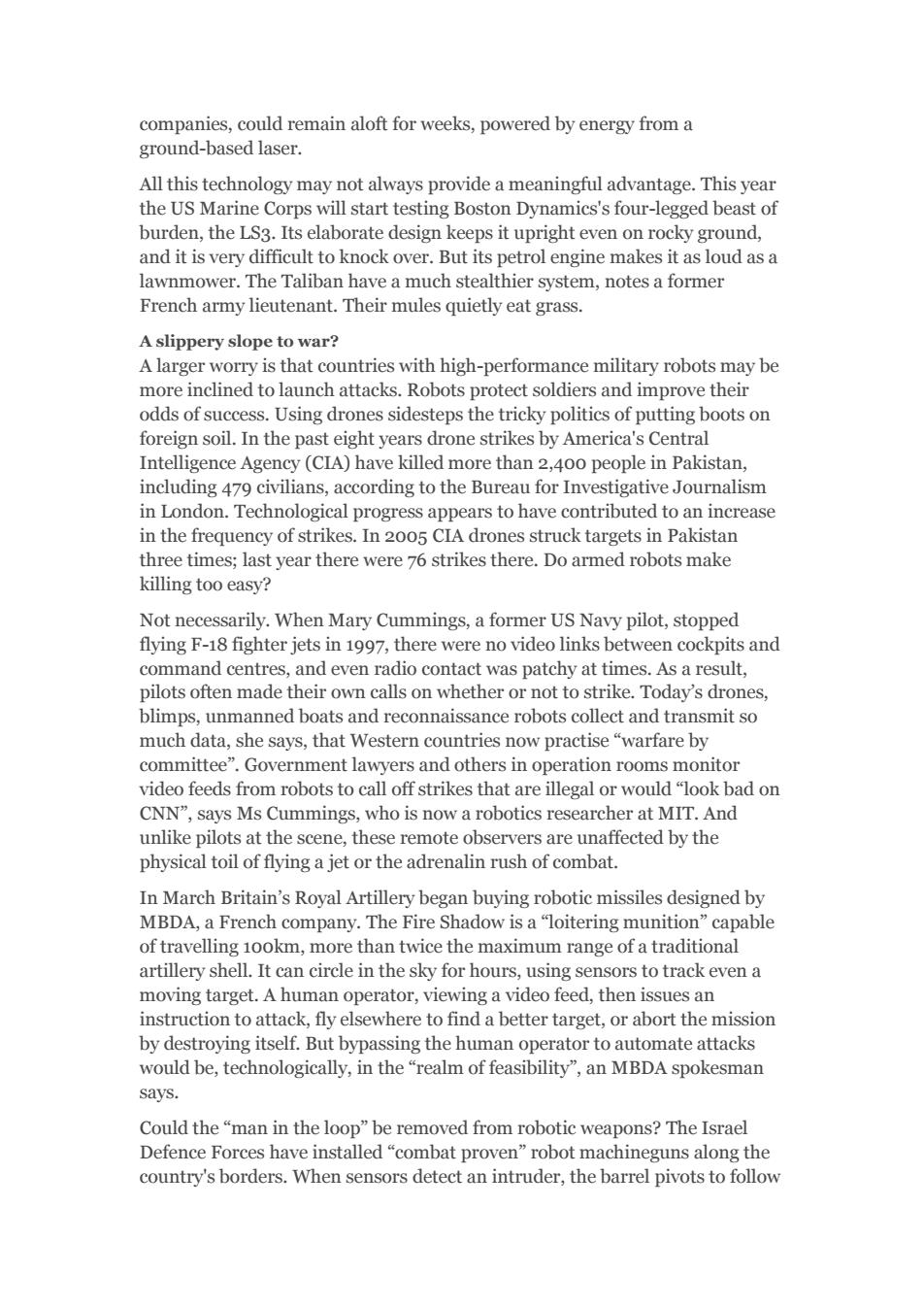正在加载图片...

companies,could remain aloft for weeks,powered by energy from a ground-based laser. All this technology may not always provide a meaningful advantage.This year the US Marine Corps will start testing Boston Dynamics's four-legged beast of burden,the LS3.Its elaborate design keeps it upright even on rocky ground, and it is very difficult to knock over.But its petrol engine makes it as loud as a lawnmower.The Taliban have a much stealthier system,notes a former French army lieutenant.Their mules quietly eat grass. A slippery slope to war? A larger worry is that countries with high-performance military robots may be more inclined to launch attacks.Robots protect soldiers and improve their odds of success.Using drones sidesteps the tricky politics of putting boots on foreign soil.In the past eight years drone strikes by America's Central Intelligence Agency(CIA)have killed more than 2,400 people in Pakistan, including 479 civilians,according to the Bureau for Investigative Journalism in London.Technological progress appears to have contributed to an increase in the frequency of strikes.In 2005 CIA drones struck targets in Pakistan three times;last year there were 76 strikes there.Do armed robots make killing too easy? Not necessarily.When Mary Cummings,a former US Navy pilot,stopped flying F-18 fighter jets in 1997,there were no video links between cockpits and command centres,and even radio contact was patchy at times.As a result, pilots often made their own calls on whether or not to strike.Today's drones, blimps,unmanned boats and reconnaissance robots collect and transmit so much data,she says,that Western countries now practise"warfare by committee".Government lawyers and others in operation rooms monitor video feeds from robots to call off strikes that are illegal or would "look bad on CNN",says Ms Cummings,who is now a robotics researcher at MIT.And unlike pilots at the scene,these remote observers are unaffected by the physical toil of flying a jet or the adrenalin rush of combat. In March Britain's Royal Artillery began buying robotic missiles designed by MBDA,a French company.The Fire Shadow is a "loitering munition"capable of travelling 1ookm,more than twice the maximum range of a traditional artillery shell.It can circle in the sky for hours,using sensors to track even a moving target.A human operator,viewing a video feed,then issues an instruction to attack,fly elsewhere to find a better target,or abort the mission by destroying itself.But bypassing the human operator to automate attacks would be,technologically,in the "realm of feasibility",an MBDA spokesman says. Could the"man in the loop"be removed from robotic weapons?The Israel Defence Forces have installed"combat proven"robot machineguns along the country's borders.When sensors detect an intruder,the barrel pivots to followcompanies, could remain aloft for weeks, powered by energy from a ground-based laser. All this technology may not always provide a meaningful advantage. This year the US Marine Corps will start testing Boston Dynamics's four-legged beast of burden, the LS3. Its elaborate design keeps it upright even on rocky ground, and it is very difficult to knock over. But its petrol engine makes it as loud as a lawnmower. The Taliban have a much stealthier system, notes a former French army lieutenant. Their mules quietly eat grass. A slippery slope to war? A larger worry is that countries with high-performance military robots may be more inclined to launch attacks. Robots protect soldiers and improve their odds of success. Using drones sidesteps the tricky politics of putting boots on foreign soil. In the past eight years drone strikes by America's Central Intelligence Agency (CIA) have killed more than 2,400 people in Pakistan, including 479 civilians, according to the Bureau for Investigative Journalism in London. Technological progress appears to have contributed to an increase in the frequency of strikes. In 2005 CIA drones struck targets in Pakistan three times; last year there were 76 strikes there. Do armed robots make killing too easy? Not necessarily. When Mary Cummings, a former US Navy pilot, stopped flying F-18 fighter jets in 1997, there were no video links between cockpits and command centres, and even radio contact was patchy at times. As a result, pilots often made their own calls on whether or not to strike. Today’s drones, blimps, unmanned boats and reconnaissance robots collect and transmit so much data, she says, that Western countries now practise “warfare by committee”. Government lawyers and others in operation rooms monitor video feeds from robots to call off strikes that are illegal or would “look bad on CNN”, says Ms Cummings, who is now a robotics researcher at MIT. And unlike pilots at the scene, these remote observers are unaffected by the physical toil of flying a jet or the adrenalin rush of combat. In March Britain’s Royal Artillery began buying robotic missiles designed by MBDA, a French company. The Fire Shadow is a “loitering munition” capable of travelling 100km, more than twice the maximum range of a traditional artillery shell. It can circle in the sky for hours, using sensors to track even a moving target. A human operator, viewing a video feed, then issues an instruction to attack, fly elsewhere to find a better target, or abort the mission by destroying itself. But bypassing the human operator to automate attacks would be, technologically, in the “realm of feasibility”, an MBDA spokesman says. Could the “man in the loop” be removed from robotic weapons? The Israel Defence Forces have installed “combat proven” robot machineguns along the country's borders. When sensors detect an intruder, the barrel pivots to follow